9 Types of Outdoor Light Bulbs (With Pictures)
-

- Last updated:

Outdoor lighting is an important aspect of any homestead. It provides crucial visibility in your yard at night, enhances your security, creates a sense of ambiance and even repels bugs. Bulbs used for outdoor lighting are different from those used indoors.
We understand that shopping for a reliable and durable outdoor light bulb can be an exhausting experience especially if you are not familiar with the different types retailing in the market. Fortunately, this article will shed some light on the different types of outdoor bulbs. We will also highlight important considerations when purchasing these outdoor light fixtures to help you with your purchase decision.
Read on to learn more!
The 9 Types of Outdoor Light Bulbs
1. Mercury Vapor
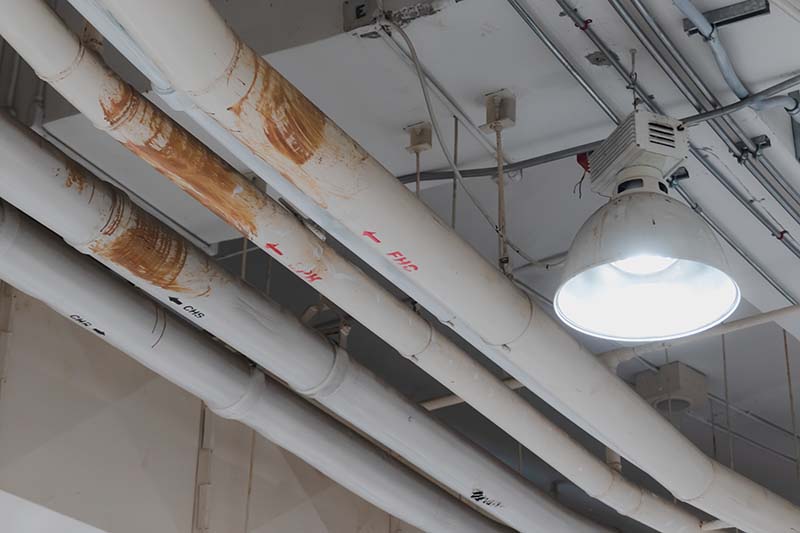
| Watts: | 250, 400, 1,000 |
| Lumens: | 10,000, 16,000, 40,000 |
| Efficacy: | 35–60 |
| CRI: | 20 |
Sometime back, mercury vapor bulbs were widely used in street lamps, outdoor home lighting, and even parking lots. However, in 2008, mercury vapor light bulbs were banned in the US 1 almost a decade after fluorescent street lights were produced. Mercury vapor lamps were a great improvement to incandescent and fluorescent bulbs. You can still find mercury vapor lights in streetlights, but the more efficient sodium lamps are slowly phasing them out.
These lamps produce light by directing an electric arc through vaporized mercury. The arc is discharged in a small fused quartz arc tube that is mounted in a glass bulb. Mercury vapor lamps produce white light with a slightly bluish-green tint that does not compliment the human skin color. However, newer versions called color-corrected mercury vapor bulbs have been coming out and producing more white light.
- More energy efficient compared to incandescent bulbs and fluorescent bulbs
- Contain hazardous emissions because it produces UV rays
- Dimmers quicker than other light bulbs
2. Metal Halide
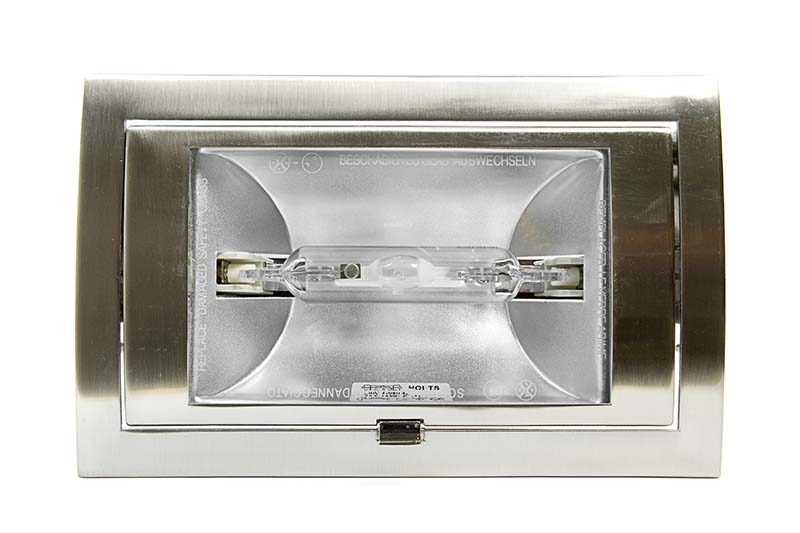
| Watts: | 250, 400, 1,000 |
| Lumens: | 22,000, 36,000, 110,000 |
| Efficacy: | 65–100 |
| CRI: | 85– 94 |
This type of bulb is used on street lamps, stadium lighting, and parking lots. It produced light by sending an electric arc to metal halides and vaporized mercury. This bulb makes a good street light bulb because it produces true white light, which is very bright. This makes the metal halide bulbs ideal for use in large areas like sports fields.
They are also utilized in a retrofit application and are available in many wattages. They can also survive up to an average of 10,000 to 12,000 hours. They are preferred to mercury bulbs because they emit very bright light with a good color rendition. Unfortunately, this bulb is a big contributor to light pollution.
- Have a great color rendition.
- Feature an improved CRI around 85
- Are very bright and contribute to light pollution
- Less efficient compared to sodium lamps
- They explode or shatter when they fail
3. High-Pressure Sodium (HPS) Street Bulbs
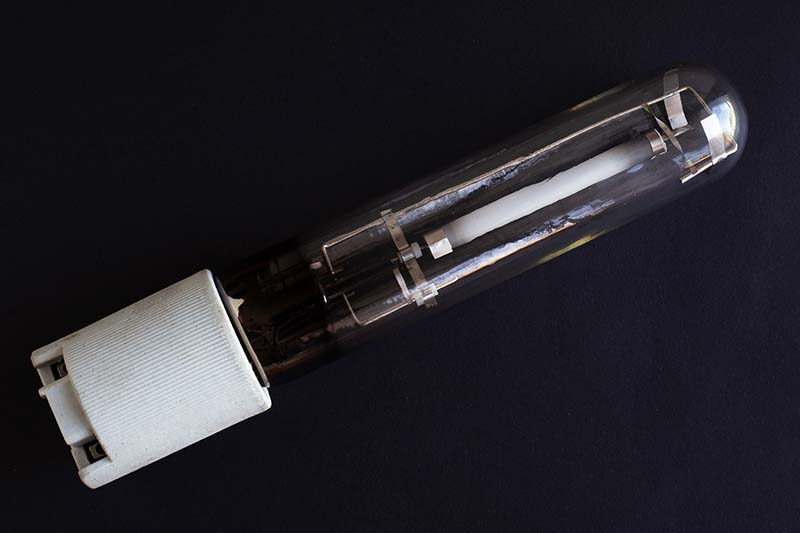
https://www.alamy.com/stock-photo/sodium-street-light.html
| Watts: | 150, 250,400 |
| Lumens: | 16,000, 24,000, 50,000 |
| Efficacy: | 40–140 |
| CRI: | 20– 4 |
High-pressure sodium lights are perhaps the most utilized bulbs for street lights today. They emit white light by passing electricity through a mixture of different gasses like sodium vapor. They are highly preferred by many people because of their low maintenance.
However, high-pressure sodium bulbs are slow to turn on and tend to produce a yellow–orange hue, which is their biggest drawback. The yellow-orange illumination can interfere with an astronomer’s ability to measure distant stars. They also have poor color rendition.
- High-pressure sodium lights are more efficient than other earlier light bulb versions
- Takes long before fully turning on
- Emits a reddish color at the end of its life cycle
- Explodes at the end of its life cycle
- Needs a current regulation transformer to change the voltage
4. Low-Pressure Sodium (LPS) Street Bulbs

| Watts: | 18, 35, 55 |
| Lumens: | 1,800, 4,550, 7,800 |
| Efficacy: | 100–200 |
| CRI: | 44 |
The low-pressure sodium bulbs are similar to the high-pressure counterparts, but with one major difference. Instead of illuminating white light, they produce exclusively yellow or warm light. LPS lamps are more efficient than their predecessors are but they also take a while before completely turning on.
They also have a poor color rendition, making objects appear gray or a different color. The light also interferes with astronomer equipment and measurements. This is perhaps why LPS bulbs are suited for low-mount applications such as lighting inside a tunnel or under a bridge.
- Lasts longer than HPS
- Emits less glare than the HPS
- Has a zero CRI rating because it can only produce a yellow light
5. Light Emitting Diodes (LED) Lights
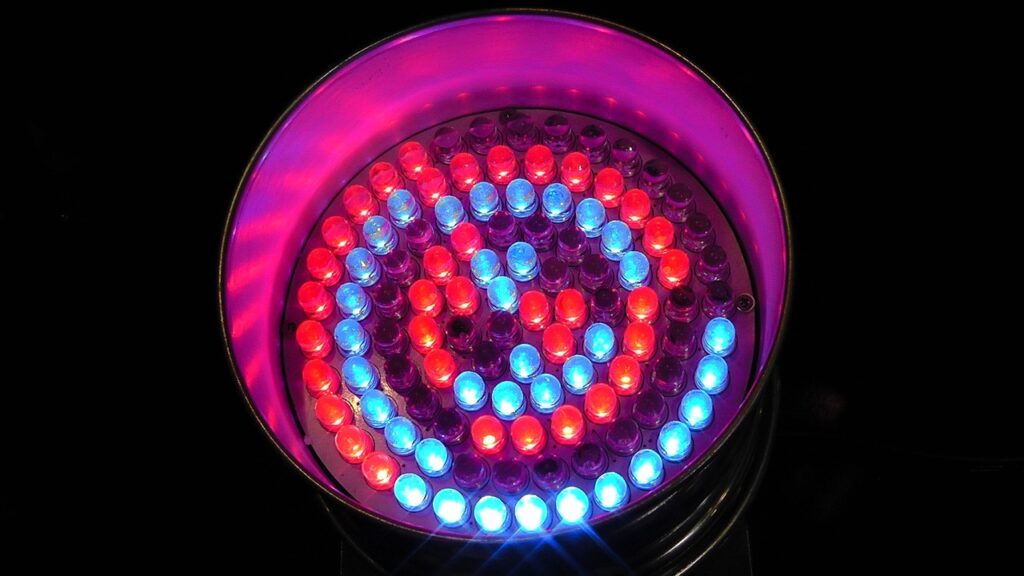
| Watts: | 42, 146, 202 |
| Lumens: | 3,648, 12,642, 13,620 |
| Efficacy: | 60–100 |
| CRI: | 80–98 |
LEDs outdoor bulbs are some of the most energy efficient for outdoor lighting. This can be attributed to the recent improvements in LED technology that allowed LED bulbs to be used in an outdoor setting. Not only do these bulbs not emit toxic chemicals like mercury vapor bulbs, but they are also extremely durable, able to clock out 50,000 hours.
LED is the most preferable type of light bulb for use with integrated solar street lights, solar street lights, and CFL lights. Unlike traditional streetlights, which produce 58LM/watt, these bulbs produce 80LM/watt. They are also easy to turn on and do not produce ultraviolet rays. The only drawback is the emission of blue/white light, which can have negative effects on people and wildlife.
Overall, LED light bulbs can be used as direct lights that can be controlled by dimming. They are also incorporated into smart solar street lights where they can increase the brightness or dim automatically depending on the controls set on the streetlights. LED bulbs require fewer maintenance practices and are cost-effective.
- Long lifespan of up to 50,000 hours.
- Are more energy efficient with reduced heat emission
- Directional light (with over 180 degrees of light direction)
- Very high-quality light
- Low maintenance costs
- Expensive
6. Phosphor-Converted Amber (PCA) LED Light Bulb
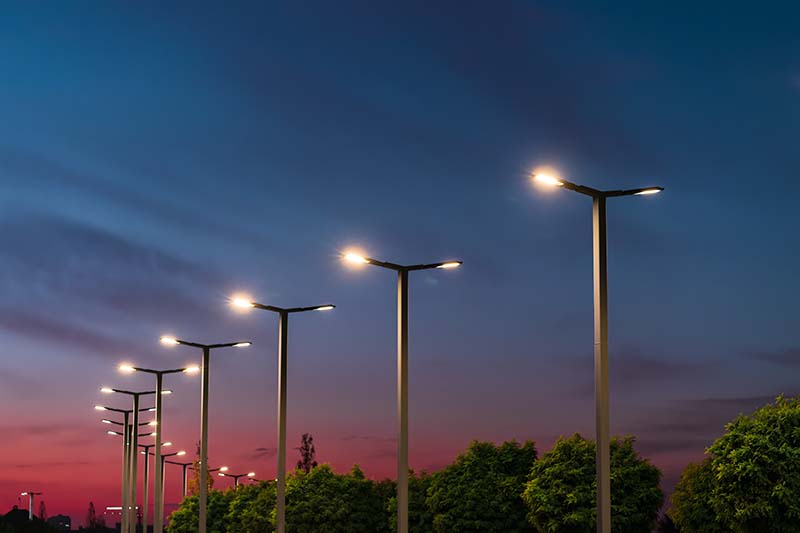
| Watts: | 100, 200, 300 |
| Lumens: | 6,100, 12,200, 18,300 |
| Efficacy: | 30–40 |
| CRI: | 59 |
Phosphor-converted amber (PCA) LED Lights are a new addition to the light bulb market. They may only have been available in the market for only three years, but they guarantee efficient lighting solutions with great color rendition. They utilize a phosphor to convert light to different hues including amber, green, yellow, and red lights. Also, unlike traditional LED light bulbs, PCA LED is monochromatic and emits a yellow glow.
Since they produce little blue light, they are very pleasing to the eyes and are a good choice to brighten up the night skies with higher lighting efficiency. The PCA light bulbs also have fewer negative impacts on animals compared to other white light sources. The only downside to PCA LEDs is that they are currently very expensive.
- Animal friendly due to their amber lighting color
- Are energy efficient like the traditional LEDs
- Very durable
- Ideal for decorative applications
- Are currently expensive
7. Narrow-Band Amber (NBA) LED Lights

| Watts: | 100, 200, 300 |
| Lumens: | 3,200, 6,400, 9,600 |
| Efficacy: | N/A |
| CRI: | N/A |
The Narrow Amber LED street light bulbs are also a new LED innovation technology. These bulbs primarily emit a warm or yellow color without using a phosphor like the traditional LED lights, which produce a bluish-white light. They also have a lower color rendition compared to PCA LEDs, but they do not mess with astronomers’ measurements.
NBA lights are also often used with endangered species like turtles because they are affected by light at night. The company that produces NBA LEDs guarantees good quality light from their products because they do not give illuminated things a gray hue.
Unfortunately, NBA LEDs can experience thermal instability, which will diminish light output over time. They may be energy efficient but currently, they have not created a solid foundation in the market and are high-priced.
- Energy Efficient
- Emit a warm or yellow color without using a phosphor
- Lower color rendition compared to PCA LEDs
- Thermal instability
8. Compact Fluorescent Lamps (CFL) Street Light Bulb
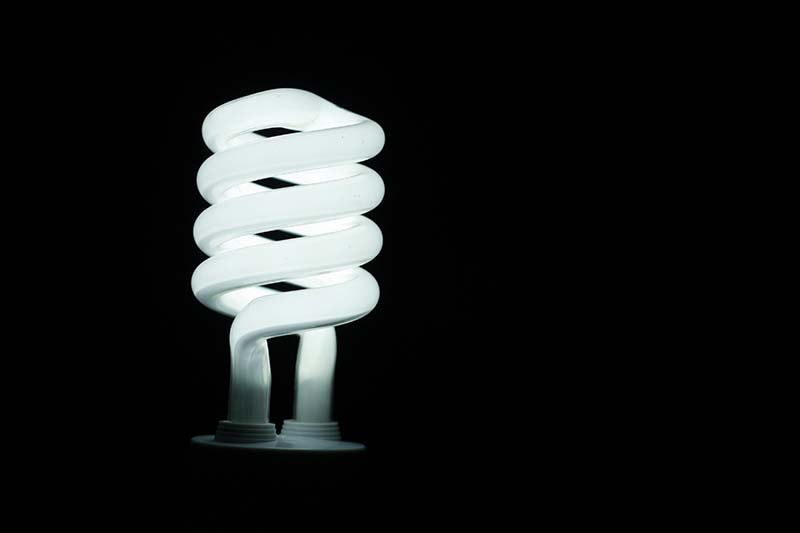
Despite the emerging solar LED street light bulbs, CFL street lights are still common in some parts of the country. These bulbs may mimic incandescent bulbs, however, they operate like fluorescent bulbs internally. This is why they are more compact than typical fluorescent bulbs. You can tell them apart by their tubular loops.
These light fixtures are mainly used in Perimeter Street and commercial building lighting. They may produce the same amount of power as fluorescent bulbs, but they use less power, making them energy efficient. They also have a longer lifespan (about 10,000 hours) when compared with incandescent bulbs.
- Lasts longer and is more efficient than fluorescent bulbs
- Beam is more direct and controlled than a fluorescent bulb
- CFLs are more compact
- Lighting intensity can reduce before finishing its lifecycle
- CFL bulbs require a ballast
9. Halogen Bulbs
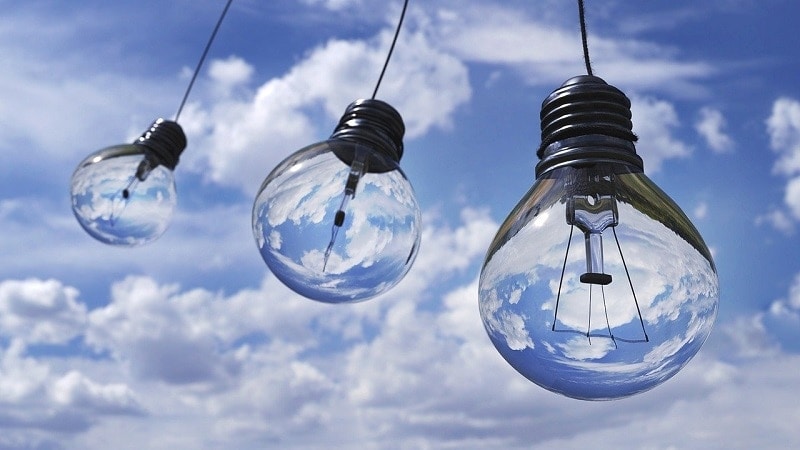
| Watts: | 53, 72, 75 |
| Lumens: | 940, 1,350, 1,500 |
| Efficacy: | 16–29 |
| CRI: | 100 |
These types of outdoor bulbs are mostly used as headlights in cars, floodlights in homes, or stadium lighting. They also work the same as incandescent bulbs by directing electricity through a tungsten filament to produce light. However, unlike incandescent bulbs, these bulbs contain halogen gas to increase brightness.
As soon as the tungsten burns off the filament, the gas replaces it on the filament for future use. This is why halogen bulbs tend to last longer than incandescent bulbs. Overall, halogen bulbs burn brighter and hotter than typical incandescent bulbs.
- Uses a tungsten filament
- Last longer than incandescent bulbs
- Hotter than typical incandescent bulbs
What to Consider When Choosing Outdoor Light Bulbs
If you are in the market for a quality light bulb for your outdoor fixtures, it is important to consider the type of bulb and its characteristics. This includes base size, brightness, energy efficiency, and water resistance. Below are some of the important attributes of some of the best light bulbs for outdoor applications.

Types of Bulb
As earlier mentioned, there are different types of outdoor light bulbs retailing in today’s market. Understanding the types and features of the nine bulbs we have highlighted above is the first step toward making a worthwhile purchase decision.
Weather Resistance
Before purchasing an outdoor bulb, you must check the weather rating on the packaging to ascertain what the bulb can handle before failing. Some outdoor bulbs have water resistance properties while others do not and therefore, are only limited for use with a protective housing. Weatherproof bulbs are suitable for use in fixtures that expose the bulb to snow and rain.
Bulb Base Size
Outdoor bulbs come with different base sizes to fit into different light fixtures. Bulbs used in spotlights, most floodlights, and entryway fixtures will only work if they have an E26 base. This is the same base size for the light bulbs used at home. Outdoor ceiling fans and string lights may require bulbs with smaller bases (E12 or E17 bases).
The best way to determine the base size that a fixture requires is to compare it to the old bulb. Some fixtures also come equipped with a sticker detailing the maximum wattage and the base size bulb that can work with it.
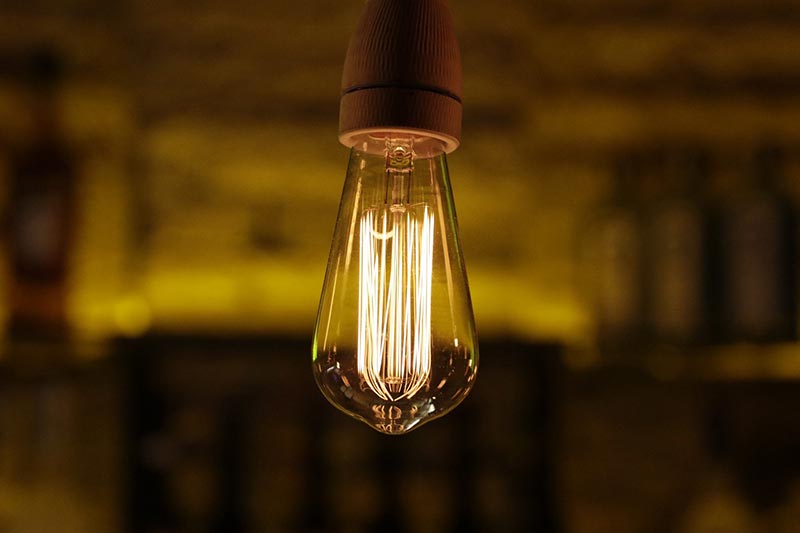
Brightness and Color Temperature
Bulbs tend to vary in brightness and the color they emit. Bulb brightness is also measured in lumens. For outdoor light fixtures, the bulbs can range from as little as 150 lumens for the decorative varieties, while some like floodlights can have as much as 1,600 lumens.
With about 600 lumens, your bulb should be able to provide visibility without glaring, making them suitable for exterior garages and porches. For security lights, get a bulb with at least 1300 lumens because security lights should offer maximum visibility at night.
The color temperature on the other hand is measured on the Kelvin (K) scale. The scale determines how cool or warm the lighting is. Warmer lighting should range from 2,700K to 3,000K. Soft light can measure 3,500K on the scale while daylight-mimicking bulbs can measure up to 6,000K.
Lifespan and Energy Efficiency
The durability of an outdoor light bulb will vary depending on the type of bulb you have on your fixture. Incandescent bulbs last the shortest period, lighting up your life for only one year before burning out. Halogen bulbs on the other hand are more durable and able to light for two to three years. LED and CFL bulbs can last 15 to 25 years and 6 to 10 years, respectively, which is the longest lifespan for outdoor bulbs.
CFL and LED bulbs also are the most energy-efficient of all outdoor light bulbs. An LED bulb can use 13 watts, while a Halogen bulb uses 14 watts to produce the same level of brightness as a 60-watt incandescent bulb. A halogen bulb would need at least 43 watts to produce the same level of brightness.
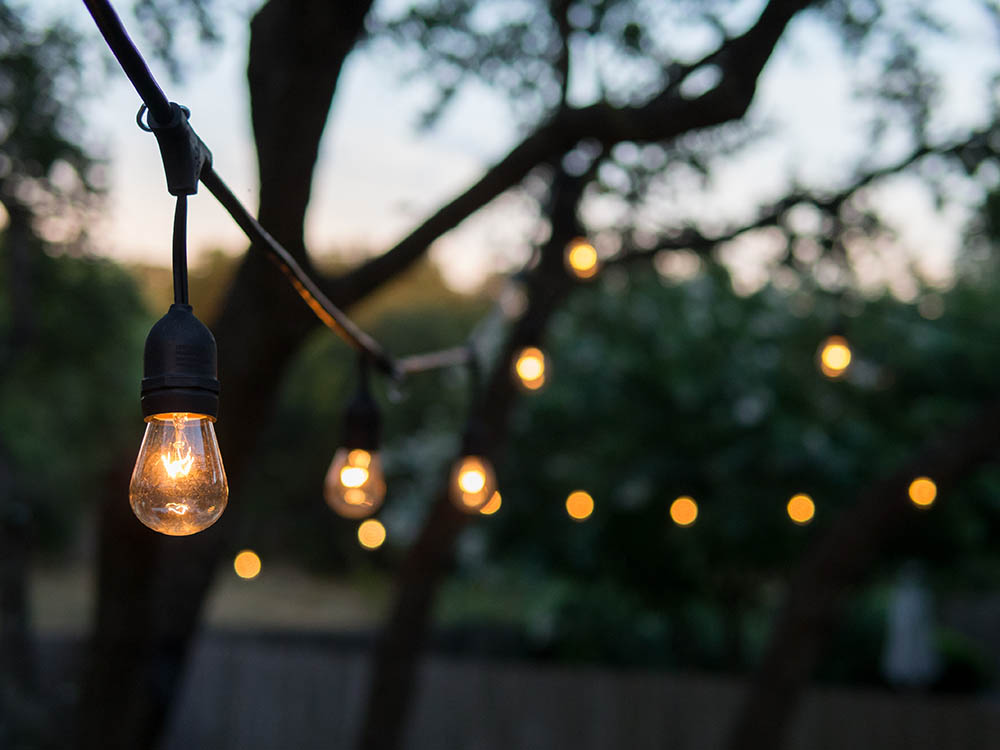
Conclusion
We hope that the article has shed some light on the best type of bulbs to use with your outdoor light fixtures. In addition, the outdoor buying guide should give you the basic knowledge required when purchasing an outdoor bulb.
Generally, LED lights are the most suitable option if you want general-purpose lighting near your home. They are the most durable and energy efficient. They also do not produce harmful carbon emissions. CFL bulbs are also a worthy consideration because they are compact, produce a direct beam, and are more efficient than fluorescents.
PCA LED lights may still be new in the industry but they are making strides by coming up with aesthetically pleasing lights ideal for use with concerts. Incandescent bulbs may be functional but they are the least durable and use more energy than other bulb types. Obviously, your choice will depend on personal needs and preferences but ensure that you get a bulb that is weather-resistant, durable, and energy efficient. Also, make sure the base size of your bulb corresponds to your light fixtures.
Featured Image Credit: Song Young, Pixabay
Contents

